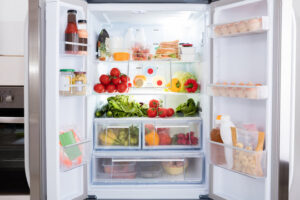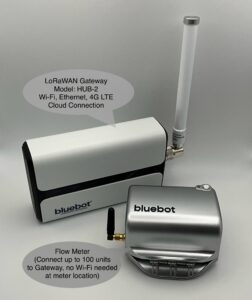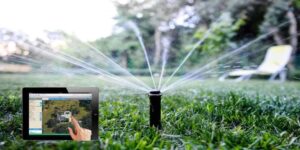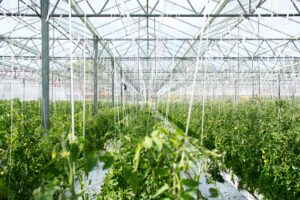

The Internet of Things (IoT) offers smart farming options, leading to more control, lower costs, and higher ROIs for farmers.
As the creators of today’s best smart water monitoring system, we here at Bluebot have outlined the latest developments in IoT tech to help farmers boost efficiency and maximize yields.
Thanks to recent advancements in smart water monitoring, controlling water flow to crops and livestock has never been simpler.
Smart water monitoring uses the newest technologies to track and manage water usage in agriculture. This allows farmers to quickly and easily improve their resource management.
Bluebot’s AI-powered flow meters—particularly the LoRa water meter and the LoRaWAN water meter—provide real-time, accurate data on water consumption.

While these devices have proven effective for residential, commercial, and light industrial needs, their applications extend to the agricultural arena as well, particularly when applied to processes such as irrigation.
The versatility of our smart water meters is due in no small part to Bluebot’s ability to adjust to 80 different combinations of pipe sizes and types.
After a simple installation, these water flow meters effortlessly establish a cost-effective wireless network across your entire property, supporting hundreds of metering points.
This ensures optimal performance across diverse agricultural settings, and using LoRa and LoRaWAN connectivity in Bluebot’s water meters provides seamless integration with existing farm systems.
One of the most widespread applications of IoT in the agricultural industry is precision farming, which uses IoT sensors to collect detailed data on crop conditions, gathering all the information needed in one place.
With IoT agriculture sensors, farmers can effortlessly monitor key variables, including:
This data allows farmers to make more precise, well-informed decisions that optimize crop health and yield.
According to recent reports, precision farming with smart agriculture sensors leads to three distinct positive outcomes.
Thanks to precision farming, profit margins widen because farmers can maximize their yields with fewer inputs.
The precise data available from precision agriculture approaches allows for a more efficient use of resources such as water, fertilizer, herbicide, and fuel.
Perhaps best of all, through smart agriculture, the less excessive use of chemicals leads to less potential runoff, creating healthier and more stable environmental conditions.
In these ways and more, precision agriculture benefits both farmers and those they serve.
Automated irrigation systems are IoT-enabled solutions that manage water distribution without direct human intervention. Such systems combine data from soil sensors with ongoing weather forecasts to adjust irrigation schedules according to realtime needs.
According to the most recent estimates, 70% of all freshwater is used for agriculture. Therefore, any irrigation system that leverages IoT advancements to conserve water will have a significant global impact.

According to climate solution experts, “Irrigation scheduling and deficit irrigation are two methods of variable application. Sensors can monitor soil moisture and control irrigation systems automatically.”
Thus, automated irrigation systems can lead to increased crop yield and significant water conservation benefits for farmers.
Livestock monitoring uses IoT devices to track and manage the health and behavior of animals. Via collar tags attached directly to the livestock, these sensors can monitor variables such as the herd’s vital signs, location, and activity levels in real-time.
With the help of these sensors, farmers can:
In these ways and more, recent IoT solutions for cattle monitoring and management contribute to an overall improvement in animal welfare and farming productivity with less active effort on the part of farmers.
Crop surveillance employs drones to monitor crop health from the air.
Between 2024 and 2031, the Global Drone Farming Market is projected to experience significant growth. And no wonder.
Using drones for crop monitoring brings significant advantages to farmers:
By capturing high-resolution images and collecting data, agricultural drones help farmers gain a comprehensive view of their fields. This information can be used to optimize various farming practices, such as precision irrigation, targeted fertilizer application, and pest control. As a result, drone farming not only improves crop yields and farm efficiency but also contributes to more sustainable and resilient agricultural practices.
It’s difficult to overstate the benefits of employing drones for crop monitoring in a farming operation. By covering large areas of land quickly and providing actionable insights for farmers with minimal effort, drones enable farmers to use their time, attention, and resources effectively.
Greenhouses aren’t just the realm of backyard hobby gardeners. Greenhouses are also employed on farms for growing at scale.
While backyard gardeners might enjoy getting into the nitty gritty details of employing manual interventions to keep their plants healthy and thriving, commercial growers rely on the automated and effective systems of smart greenhouses to lessen the need for daily concentrated attention and remove a level of guesswork from the equation.

Smart greenhouses maintain controlled environments enhanced by IoT technologies. In a smart greenhouse, different types of IoT sensors both monitor and regulate internal conditions such as temperature, humidity, and light. These sensors, in turn, trigger different automations within pre-set climate control systems in the greenhouse to maintain optimal growing conditions.
In this way, growers can effortlessly maintain optimal conditions through smart greenhouse management, leading naturally to both increased productivity and greater energy efficiency.
There was a time when farming was almost entirely dependent on the whims of weather. Farmers could study the almanac, but even with that as a baseline, they really had no way of telling what the next day’s weather might bring.
Now, with the help of predictive analytics, farmers can use IoT-collected data to forecast crop growth and get ahead of any potential issues. By analyzing the real-time data they receive from sensors and leveraging software applications to compare it against historical records to predict the most likely outcomes, they can manage their crops with much greater confidence.
The benefits of using predictive analytics for crop management are manifold. With these accurate predictions in hand, farmers can make detailed plans for entire seasons.
With the help of predictive analytics for crop management, farmers can remove the guesswork from their planning, from planting to harvesting. By relying on more informed decision-making with smart agriculture devices, they can reduce losses and maximize crop yields.
Supply chain optimization leverages IoT to streamline the movement of agricultural products from farm to market.
Since the global disruption of the COVID-19 pandemic “brought to light previously unseen vulnerabilities” and “accelerated and magnified problems” that already existed in the supply chain, focusing on supply chain optimization may be more important now than ever before.
Fortunately, with applications from IoT, real-time tracking devices can monitor the location and condition of goods during transit. That means farmers have access to unprecedented levels of transparency, traceability, and inventory management as they transfer their resources from the fields to the stores, markets, and individual consumers around the country and even the world.
Through increased supply chain visibility, farmers and consumers alike can enjoy the benefits of:
Smart pest management involves using IoT technologies to detect and control pest activity. A combination of sensors and image technology work together to identify the presence of pests. These finely tuned automated systems can lead to the earliest possible detection to trigger targeted interventions.
Because smart pest management is responsive to immediate needs, this leads naturally to a reduction in chemical usage and crop damage through precise pest control measures.
Not only does smart pest management minimize crop damage from pests, thereby leading to increased crop yield and significant economic benefits, but it also carries environmental implications. Reducing pesticides reduces runoff and lessens the overall impact on the surrounding ecosystems.
Climate monitoring involves the continuous observation of environmental conditions via IoT sensors.
Thanks to these sensitive on-site “weather stations” placed around the farm, data on things like air temperature and pressure, humidity, wind speeds, the dew point, and changing weather patterns are collected. They are then sent to the cloud for easy access and analysis in real-time.
With continuous access to the most updated information, farmers can adapt as needed to changing climate conditions, ensuring crop resilience.
Over time, using IoT for proactive climate adaptation strategies will lead to reduced risk factors in farming and enhanced climate resilience, both necessary steps in long-term sustainability in the agriculture industry.
Even a cursory glance at the list above makes it easy to recognize the transformative impact IoT applications have had on modern agriculture.
Especially in recent years, advancements in IoT technology, including devices like Bluebot’s innovative smart water flow meters, have led to enhanced efficiency, sustainability, and productivity in smart farming.
Fortunately, this is just the beginning. As emerging digital technologies continue to develop and come onto the market, we look forward to seeing how new precision farming techniques made possible by IoT will address ongoing challenges in agriculture.
As farmers, growers, agribusiness owners, and investors sit down and consider their options, it would be in their best interests to spend time researching and learning more about IoT solutions.
While circumstances—and, therefore, needs—vary, this much is clear: in the coming days, adopting the right IoT solutions for the agriculture market will be critical to staying competitive in a busy market and ensuring long-term success in the agricultural industry.